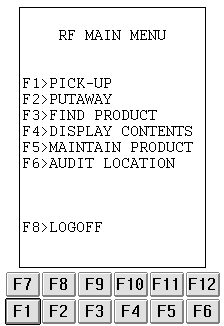

 |  |
| MISSION PRODUCTS NEWS CONTACT | |
| T L S | Web-Based
The^Locator System |
The Locator System (TLS) is an intranet-based inventory tracking and management system. TLS provides Inventory Core functionality using both Radio Frequency (RF) and Browser-Based Graphical (GUI) user interfaces. TLS' distributed implementation provides scalability and reliability while controlling complexity and hardware costs. The software uses an expandable peer-to-peer architecture allowing easy expansion of functionality to meet the client's needs.
TLS can be used by any operation that requires inventory-by-location information. TLS is used in distribution centers to provide immediate access to changing product locations and inventory levels. In manufacturing environments, it provides visibility to stored Work-In-Process (WIP) as well as raw materials tracking. TLS can even be used to track spare parts inventories for any industry, from the smallest bolt and nut to electric utility substation transformers.
BenefitsTLS delivers immediate benefits including:
|
FunctionsTLS provides all of the functions necessary for a locator solution including:
|
All inventory events are logged allowing production of summary productivity reports. Analysis of these events can lead to development of new procedures improving overall operational efficiency.
User InterfaceBrowser-Based Graphical InterfaceTLS uses industry-standard, browser-based, HTTP-served, HTML forms as the primary user interface. Any workstation with a browser and a TCP/IP link to the TLS host can access the system's functions. This "thin client" approach reduces the cost of installation and maintenance and extends application access to the entire enterprise (with proper security provided). With TLS, customer support personnel have direct access to the current order status information; order entry personnel have direct access to the current inventory levels; all without adding any software to their workstations! TLS screens are fully "hot-linked" to minimize operator entry of fields such as product or location IDs. For instance, actual inventory in a location is simply a mouse-click away from location maintenance.
| |
|
TLS reports are provided to the browser for viewing, saving, or printing as desired by the operator.
| |
Radio Frequency (RF) InterfaceTLS' RF interface provides access to the system's functions directly from the "floor." As operators pick or place inventory, their updates are instantly visible to all other operators. Any query will reflect the current product location and quantity. As operators work with the system, any holds or locks are automatically presented on their screens. Held product or locked locations can be accessed with TLS providing historical tracking of the actions. The RF interface is streamlined to automatically cycle between pick and put operations. Each of the screens provides function key access to related operations with key information automatically provided as defaults. Since the TLS RF interface is browser-based, additional web-based information and applications can be accessed extending the reach of other applications. Specialized screen flow and additional functions are as easy as adding additional HTML forms with embedded REXX processing scripts. |

|
Contact
For additional information or to arrange a TLS demonstration, please contact:
 |
Compass Solutions, Inc. |
| Copyright © 2000 Compass Solutions, Inc. |